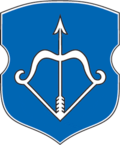Brest, Belarus
|
|
- For a city in France, see Brest, France.
Brest (Belarusian: Бе́расьце, Брэст | Bieraście, Brest; also known as Brest-Litovsk and in Polish as Brześć Litewski, Brześć nad Bugiem or Brześć Białoruski; Russian: Брест, Lithuanian: Lietuvos Brasta (litterally meaning "shallows of Lithuania") is a city (population 290,000 in 2004) in Belarus close to the Polish border where the Western Bug and Mukhavets Rivers meet. It is the capital city of the Brest voblast and is located at Template:Coor dm.
It was a main railroad transfer point during Soviet times and it remains a rail transfer point and customs/immigration checkpoint on the Berlin/Moscow rail line. Some of the land in the rail yards is contaminated due to transhipping of radioactive materials during the Soviet regime. In Brest the rail cars had to be transferred between the Russian broad gauge and the European standard gauge.
| Contents |
History
The city was founded by Slavs as Bereste in 1017 but was conquered by the Mongols in 1241 and by Lithuania in 1319. It was renamed Brest-Litovsk in the 14th century and became part of the Polish-Lithuanian Commonwealth in 1569. In 1596 it hosted the council which established the Eastern Catholic or Uniate Church.
Brest passed to Russia when Poland-Lithuania was partitioned for a third time in 1795. It was captured by the German Empire in 1915, during World War I. In March 1918, in a fortress on the western outskirts of Brest at the confluence of the Western Bug and Mukhavets Rivers, the Treaty of Brest-Litovsk was signed, ending the war between Russia and the Central Powers and transferring the city and its surrounding region to the sphere of influence of the German Empire. This treaty was subsequently annulled by the treaties which ended the war.
The newly reconstituted Poland took control of Brest in 1919. The city changed hands twice during the Polish-Soviet War and eventually stayed inside Polish borders, a development that was formally recognised by the Treaty of Riga in 1921. The Brest fortress, heavily damaged during World War I, was turned into war materiel magazines and its central part into a prison. In 1930 a trial of Wincenty Witos took place there. During the Polish September Campaign the city was defended by a small force of four infantry batalions under Gen. Konstanty Plisowski against the XIX Panzer Corps of Gen. Heinz Guderian. After four days of heavy fighting the Polish forces withdrew southwards on September 17.
The city was invaded and annexed by the Soviet Union in 1939 in accordance with the Ribbentrop-Molotov pact partitioning Poland signed with Nazi Germany in August, 1939. Most Belarusans considered it a reunification of the Belarusan nation under one constituency (BSSR at that time).
On June 22, 1941 the city was attacked by Nazi Germany at the beginning of Operation Barbarossa, with the fortress in which the 1918 treaty had been signed acting as the focal point for the resistance. It held out for a month, establishing the city's status as the only Hero-Fortress among the Hero Cities of the Soviet Union. Brest's Jewish community was decimated under Nazi rule. The city was retaken by Soviet forces in 1944.
According to agreements of the Yalta Conference of February 1945, Brest changed hands yet again, being passed to the Belarusian Soviet Socialist Republic. It is now part of the independent country of Belarus.
Sights in and around Brest
A majestic Soviet style memorial was constructed on the site of the 1941 battle to commemorate the known and unknown defenders of the fortress. This war memorial is the largest tourist attraction of the city. In addition, an archeological museum of the old city is located near the site of the fortress. It offers objects and huts dated back to the 13th century that were found during excavations in the 1970s.
Belavezhskaya Pushcha National Park, 70 km north of Brest, is a biosphere reserve of world distinction and can be reached by car or bus. This virginal forest is home to rare European bison (wisent). There is a museum and zoo for tourists in the forest along with a small hotel and restaurant. Animals can be seen also in inclosures all the year round. Excursions can also be taken by horse and cart into the interior of the forest. Much logging is being done in the area to the consternation of nature preservationists.
The village of Kosava, where Tadeusz Kosciuszko was born, is also in the Brest region and features 19th century palace and Roman Catholic church.
Brest also hosts the first Belarusian outdoor railway museum.
A Holocaust memorial commemorates the dead Jews of Brest ghetto.
The local airport (code BQT), which has been closed since the breakup of the Soviet Union has recently began operating flights to the capital city Minsk and to Moscow and Novgorod in Russia on a weekly basis.
Individuals associated with Brest
- Menachem Begin, former prime minister of Israel.
- David Dubinsky, former head of the Amalgamated Clothing Workers of America
- Louis Gruenberg, composer
- Joseph Soloveitchik, Modern Orthodox Jewish Rabbi.
See also
External links
- http://www.brestonline.com
- http://www.brest-bel.narod.ru
- The Brest Fortress (http://city.bresttelecom.by/ct/page1e.html)
- Photos on Radzima.org (http://radzima.org/pub/miesta.php?miesta_id1=brbrbier)
- entry on Brest (http://www.encyclopediaofukraine.com/display.asp?AddButton=pages\B\R\Brest.htm) in the Encyclopedia of Ukrainebg:Брест (Беларус)
be:Берасьце de:Brest (Belarus) et:Brest (Valgevene) es:Bierascie fr:Brest (Biélorussie) nl:Brest (Wit-Rusland) ja:ブレスト (ベラルーシ) pl:Brześć ru:Брест (Белоруссия) uk:Брест

